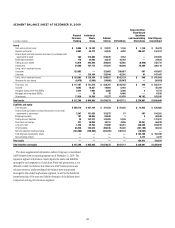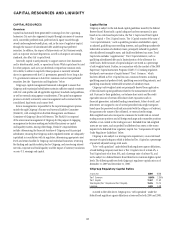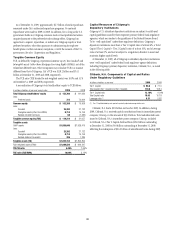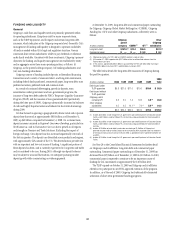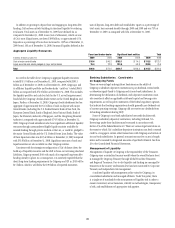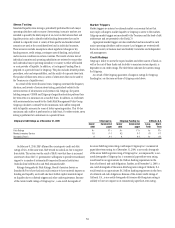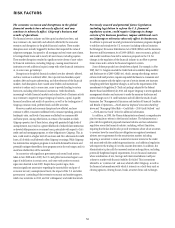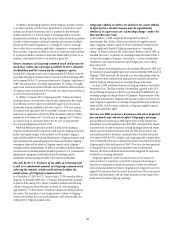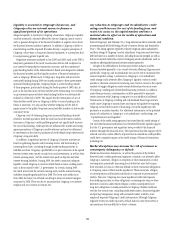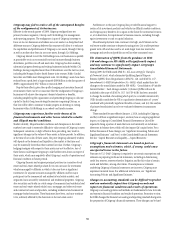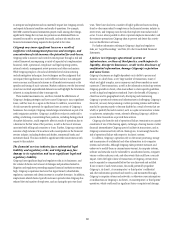Citibank 2009 Annual Report Download - page 61
Download and view the complete annual report
Please find page 61 of the 2009 Citibank annual report below. You can navigate through the pages in the report by either clicking on the pages listed below, or by using the keyword search tool below to find specific information within the annual report.
51
Stress Testing
Simulated liquidity stress testing is periodically performed for each major
operating subsidiary and/or country. Stress testing / scenario analyses are
intended to quantify the likely impact of an event on the balance sheet and
liquidity position and to identify viable funding alternatives that can be
utilized in a liquidity event. A variety of firm-specific and market-related
scenarios are used at the consolidated level and in individual countries.
These scenarios include assumptions about significant changes in key
funding sources, credit ratings, contingent uses of funding, and political
and economic conditions in certain countries. The results of stress tests of
individual countries and operating subsidiaries are reviewed to ensure that
each individual major operating subsidiary or country is either self-funded
or a net provider of liquidity. In addition, a Contingency Funding Plan is
prepared on a periodic basis for Citigroup. The plan includes detailed policies,
procedures, roles and responsibilities, and the results of corporate stress tests.
The product of these stress tests is a series of alternatives that can be used by
the Treasurer in a liquidity event.
As a result of the recent financial crisis, Citigroup increased the frequency,
duration, and severity of certain stress testing, particularly related to the
interconnection of idiosyncratic and systemic risk. Citigroup, the parent
holding company, CGMHI and Citigroup’s largest bank entities perform their
key stress tests at a minimum on a monthly basis. In addition, in conformity
with recommendations made by the Credit Risk Management Policy Group,
Citigroup calculates a stressed 30-day maximum cash outflow compared
with its liquidity resources for some of its key operating entities. This 30-day
maximum cash outflow is performed on a daily basis. For other entities, stress
testing is performed at a minimum on a quarterly basis.
Market Triggers
Market triggers are internal or external market or economic factors that
may imply a change to market liquidity or Citigroup’s access to the markets.
Citigroup market triggers are monitored by the Treasurer and the head of risk
architecture and are presented to the FinALCO.
Appropriate market triggers are also established and monitored for each
major operating subsidiary and/or country. Local triggers are reviewed with
the local country or business Asset and Liability Committee and independent
risk management.
Credit Ratings
Citigroup’s ability to access the capital markets and other sources of funds, as
well as the cost of these funds and its ability to maintain certain deposits, is
dependent on its credit ratings. The table below indicates the current ratings
for Citigroup.
As a result of the Citigroup guarantee, changes in ratings for Citigroup
Funding Inc. are the same as those of Citigroup noted above.
Citigroup’s Debt Ratings as of December 31, 2009 Citigroup Inc. Citigroup Funding Inc. Citibank, N.A.
Senior
debt
Commercial
paper
Senior
debt
Commercial
paper
Long-
Term
Short-
Term
Fitch Ratings A+ F1+ A+ F1+ A+ F1+
Moody’s Investors Service A3 P-1 A3 P-1 A1 P-1
Standard & Poor’s A A-1 A A-1 A+ A-1
On February 9, 2010, S&P affirmed the counterparty credit and debt
ratings of Citi. At the same time, S&P revised its outlook on Citi to negative
from stable. This action was the result of S&P’s view that there is increased
uncertainty about the U.S. government’s willingness to provide extraordinary
support to a number of systematically important financial institutions.
Outlooks from both Moody’s and Fitch remained stable.
Ratings downgrades by Fitch Ratings, Moody’s Investors Service or
Standard & Poor’s have had and could continue to have material impacts on
funding and liquidity, and could also have further explicit material impact
on liquidity due to collateral triggers and other cash requirements. Because
of the current credit ratings of Citigroup Inc., a one-notch downgrade of
its senior debt/long-term rating could impact Citigroup Inc.’s commercial
paper/short-term rating. As of December 31, 2009, a one-notch downgrade
of the senior debt/long-term rating of Citigroup Inc., accompanied by a one-
notch downgrade of Citigroup Inc.’s commercial paper/short-term rating,
would result in an approximate $4.2 billion funding requirement in the
form of collateral and cash obligations. Further, as of December 31, 2009, a
one-notch downgrade of the senior debt/long-term ratings of Citibank, N.A.
would result in an approximate $4.2 billion funding requirement in the form
of collateral and cash obligations. Because of the current credit ratings of
Citibank, N.A., a one-notch downgrade of its senior debt/long-term rating is
unlikely to have any impact on its commercial paper/short-term rating.



